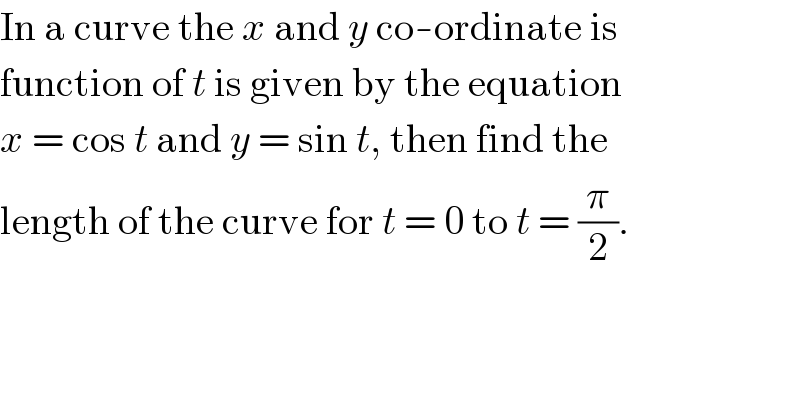
Question Number 15045 by Tinkutara last updated on 07/Jun/17

$$\mathrm{In}\:\mathrm{a}\:\mathrm{curve}\:\mathrm{the}\:{x}\:\mathrm{and}\:{y}\:\mathrm{co}-\mathrm{ordinate}\:\mathrm{is} \\ $$$$\mathrm{function}\:\mathrm{of}\:{t}\:\mathrm{is}\:\mathrm{given}\:\mathrm{by}\:\mathrm{the}\:\mathrm{equation} \\ $$$${x}\:=\:\mathrm{cos}\:{t}\:\mathrm{and}\:{y}\:=\:\mathrm{sin}\:{t},\:\mathrm{then}\:\mathrm{find}\:\mathrm{the} \\ $$$$\mathrm{length}\:\mathrm{of}\:\mathrm{the}\:\mathrm{curve}\:\mathrm{for}\:{t}\:=\:\mathrm{0}\:\mathrm{to}\:{t}\:=\:\frac{\pi}{\mathrm{2}}. \\ $$
Answered by mrW1 last updated on 07/Jun/17
![dL=(√((dx)^2 +(dy)^2 ))=(√((−sin t)^2 +(cos t)^2 ))dt=dt L=∫_0 ^(π/2) dL=[t]_0 ^(π/2) =π/2](Q15061.png)
$$\mathrm{dL}=\sqrt{\left(\mathrm{dx}\right)^{\mathrm{2}} +\left(\mathrm{dy}\right)^{\mathrm{2}} }=\sqrt{\left(−\mathrm{sin}\:\mathrm{t}\right)^{\mathrm{2}} +\left(\mathrm{cos}\:\mathrm{t}\right)^{\mathrm{2}} }\mathrm{dt}=\mathrm{dt} \\ $$$$\mathrm{L}=\int_{\mathrm{0}} ^{\pi/\mathrm{2}} \mathrm{dL}=\left[\mathrm{t}\right]_{\mathrm{0}} ^{\pi/\mathrm{2}} =\pi/\mathrm{2} \\ $$
Commented by Tinkutara last updated on 07/Jun/17

$$\mathrm{Thanks}\:\mathrm{Sir}! \\ $$
Commented by arnabpapu550@gmail.com last updated on 12/Jun/17

$$\mathrm{Please}\:\mathrm{try}\:\mathrm{question}\:\mathrm{No}.\:\mathrm{15661} \\ $$$$ \\ $$
